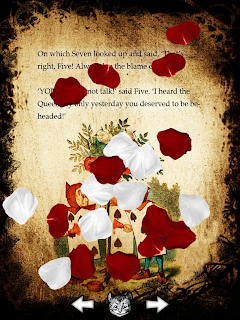 | |
| Alice in Wonderland, Tenniel illustration |
 |
| Alice for the iPad |
An application is available for free download on
iTunes called “Alice for the iPad” which presents the story of Alice’s Adventures in Wonderland on a
digital platform. The most interesting decision to me in this digitized version
was the choice to animate some of the illustrations. While there are static
black-and-white Tenniel images throughout the story, the chapter pages and some
additional pages have coloured illustrations that move. The reader can interact
with the illustration, making heads move or items float around. Tilting the
iPad around allows the user to interact with the story in their own way,
whether it’s making Alice rock the pig faster, or scatting rose petals across
the page.
The animation of these illustrations is
meant to physically engage the reader in a different way, or entice those that
would not have read the story to continue. The story can become more of an interactive experience, in a different way than a paper copy. Personally, I thought it was a very
interesting choice to use early examples of the illustrations in a
contemporary, digital version. Is it for nostalgia sake, using the older images
for a more “true” representation of the original work, distancing us from
Disney’s Alice? If that is the
intention, then why consciously decide to alter it by allowing moving images? To
me, the iPad application could speak to the power of the illustrations to draw
you into the story. Unlike many contemporary picture books, Tenniel’s
illustrations aren’t on every page of the story. But when they occur, they
bring you one step closer into Wonderland.
Maybe the representation of the book is meant to
show how a story written one-hundred and fifty years ago is still relevant. The
digital pages are darkened with blackened edges, and the illustrations are
fitting. Maybe not all good things are lost in a world that actively digitizes
its past.
 |
| Alice in Wonderland, Tenniel illustration |
Sources:
Alice in Wonderland. "Alice's Adventures in Wonderland." Accessed January 28, 2016. http://www.alice-in-wonderland.net/resources/pictures/alices-adventures-in-wonderland/
Links:
Check out Alice for the iPad here: https://itunes.apple.com/ca/app/alice-for-the-ipad/id354537426?mt=8
This is very interesting. I'm glad you wrote about your previous project on 'Alice,' of course in part due to my personal interest in the subject, but also in exploring this sort of alteration of a historical text into the realm of the digital. I am looking forward to experiencing the animated illustrations myself!
ReplyDelete